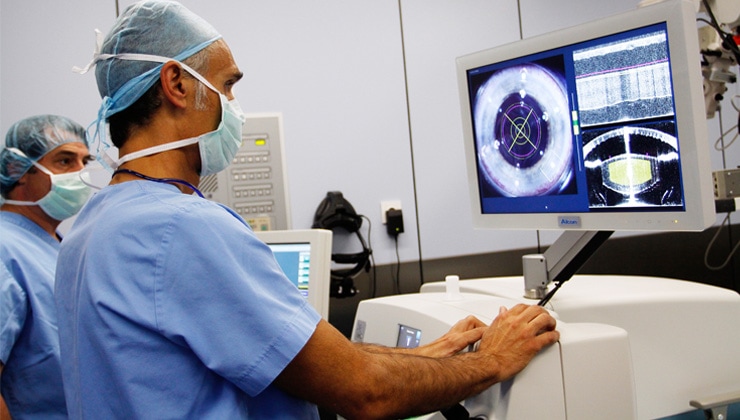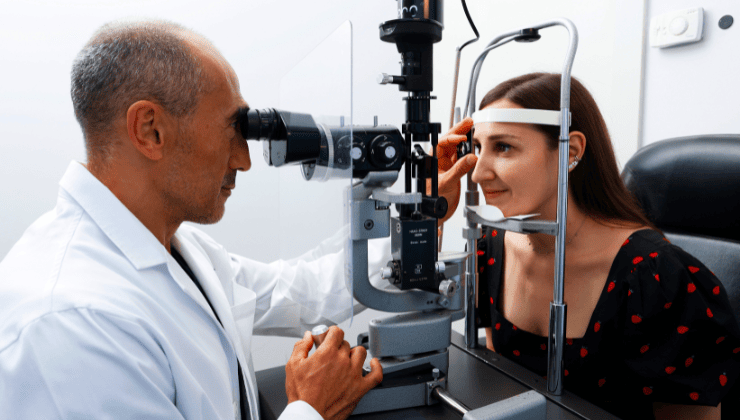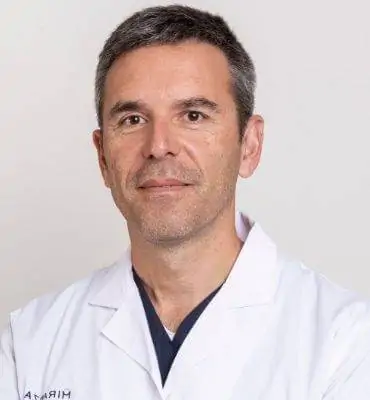What does it involve?

It is the most precise laser that currently exists in eye surgery, used during the last ten years, thanks to its speed and safety.
This laser works at a millionth of a second and reproduces the micro-incisions the surgeon has previously designed by computer, with micrometric precision, to which it is connected. It therefore does not depend so much on the ophthalmologist’s manual skills and the results are more predictable.
Another distinguishing feature of the femtosecond laser is its reversibility, as it splits the tissue by placing minimum doses of energy to produce a disruption between the cells. Hence, it uses infrared light to avoid cutting with burns or heat transfer to the cornea. Despite all of these advantages, it is not recommended or is not the best option for certain patients.
In which cases is it used?
IMO has two femtosecond laser units: the first for refractive surgery and cornea transplants and the second for cataract surgeries.
In terms of refractive surgery, the femtosecond laser has allowed for the development of new techniques such as Relex SMILE, which uses this laser exclusively to correct myopia and astigmatism through a micro-incision of barely 2 mm (without the need to open a circular layer on the surface of the cornea). It has also contributed towards selective cornea transplant techniques such as DMEK, in which only the thin Descemet’s membrane and the endothelium (layer behind the cornea) are replaced.
Furthermore, the advantages of the femtosecond laser have also been used in cataract surgery, perfecting and standardising the traditional procedure through ultrasound phacoemulsification. The new mechanism allows for more precise incisions, reduces the risk of infection, improves the positioning of the intraocular lens and makes the correction of astigmatism associated to this surgery more foreseeable. As a result, it is especially recommended in certain complex cases, such as congenital and juvenile or post-trauma cataracts.
Prior examination

Prior examinations will depend on the surgery in which the laser is used.
Associated pathologies
Experts performing this treatment
IMO Institute of Ocular Microsurgery
Josep María Lladó, 3
08035 Barcelona
Phone: (+34) 934 000 700
E-mail: international@imo.es
See map on Google Maps
By car
GPS navigator coordinates:
41º 24’ 38” N – 02º 07’ 29” E
Exit 7 of the Ronda de Dalt (mountain side). The clinic has a car park with more than 200 parking spaces.
By bus
Autobus H2: Rotonda de Bellesguard, parada 1540
Autobus 196: Josep Maria Lladó-Bellesguard, parada 3191
Autobuses H2, 123, 196: Ronda de Dalt – Bellesguard, parada 0071
How to arrive at IMO from:
IMO Madrid
C/ Valle de Pinares Llanos, 3
28035 Madrid
Phone: (+34) 910 783 783
See map in Google Maps
Public transport
Metro Lacoma (líne 7)
Autobuses:
- Lines 49 & 64, stop “Senda del Infante”
- Line N21, stop “Metro Lacoma”
Timetables
Patient care:
Monday to Friday, 8 a.m. to 8 p.m.
IMO Andorra
Av. de les Nacions Unides, 17
AD700 Escaldes-Engordany, Andorra
Phone: (+376) 688 55 44
See map in Google Maps
IMO Manresa
C/ Carrasco i Formiguera, 33 (Baixos)
08242 – Manresa
Tel: (+34) 938 749 160
See map in Google Maps
Public transport
FGC. Line R5 & R50 direction Manresa. Station/Stop: Baixador de Manresa
Timetables
Monday to Friday, 08:30 A.M – 13:30 PM / 15:00 PM – 20:00 PM









